A couple of weeks ago, this data analysis on the MLS mid-season MVPs put forth the five most impressive candidates from a data perspective.
No goalkeeper has ever won the MVP award, but the hot take to emerge was that Andre Blake, the Philadelphia Union’s Jamaican goalkeeper, is the frontrunner for prize.
But that was just the data analysis. With the performances he’s putting in this season, Blake deserves his own scout report.
And that’s what you get in this tactical analysis. We’ll look at Blake’s impact on the pitch through both data visuals and tactical images. We’ll show how he impacts play for the Philadelphia Union, why he’s the league’s premier sweeper-keeper and highlight some of his top goalkeeping qualities.
How Blake impacts play
As a reminder of the season Blake is having, let’s refer back to his mid-season data profile.
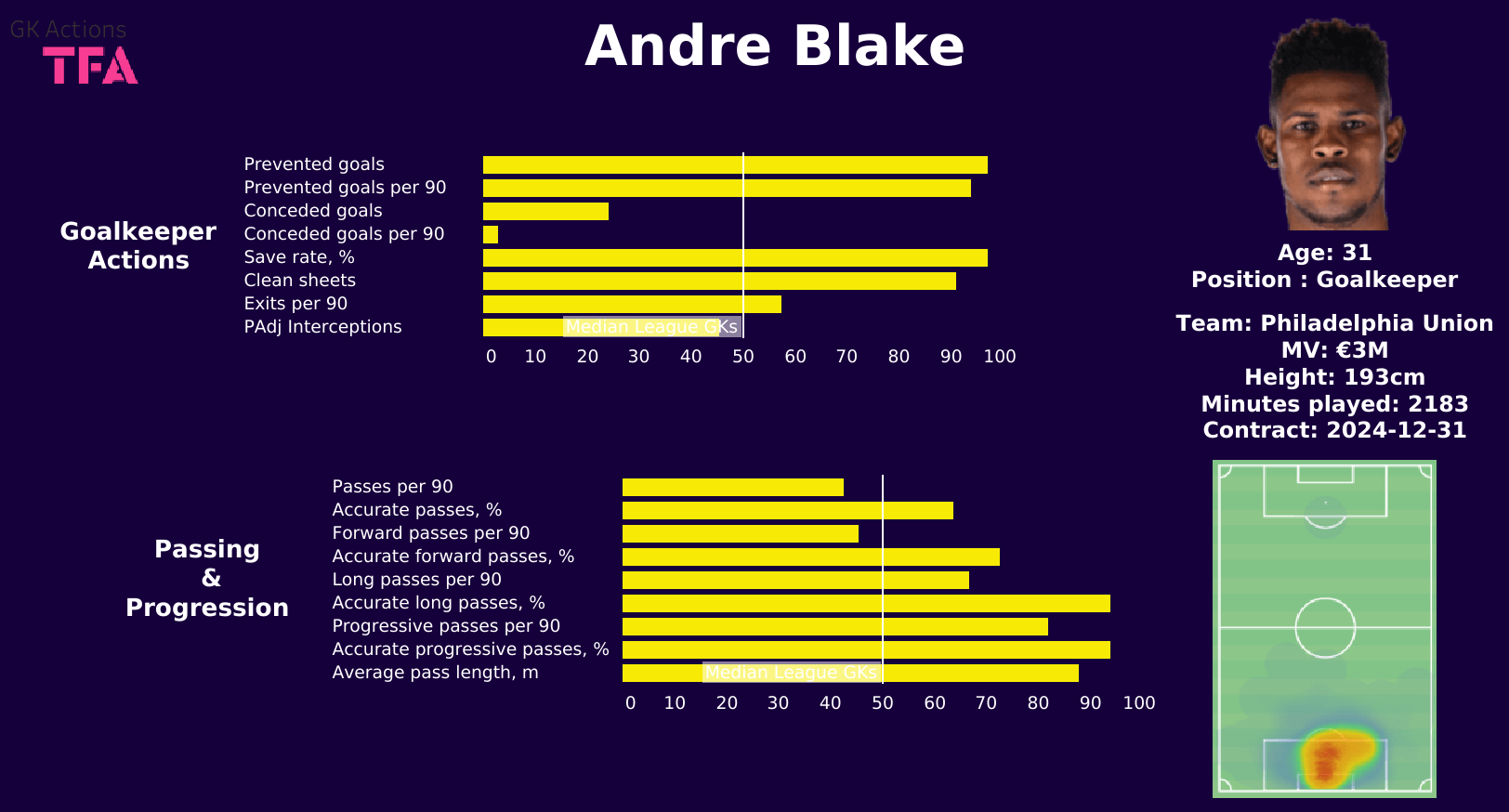
Remember that his percentile ranks in conceded goals and conceded goals P90 minutes are actually reversed, so those are league-leading totals.
In terms of this passing and progression, the number of passes he sends on a P90 basis rate is slightly below the median, but in terms of efficiency, his number is ranged from good to great.
Within that data profile, it’s his prevented goals data that is most impressive. The statistic is based on expected goals on target (xGOT). Basically, if a shot is on target, what value has the goalkeeper added to his team through his shot-stopping ability?
In MLS, few rate higher than Blake. But it’s not just MLS where the Jamaican’s prevented goals tally is among the best in the player pool.
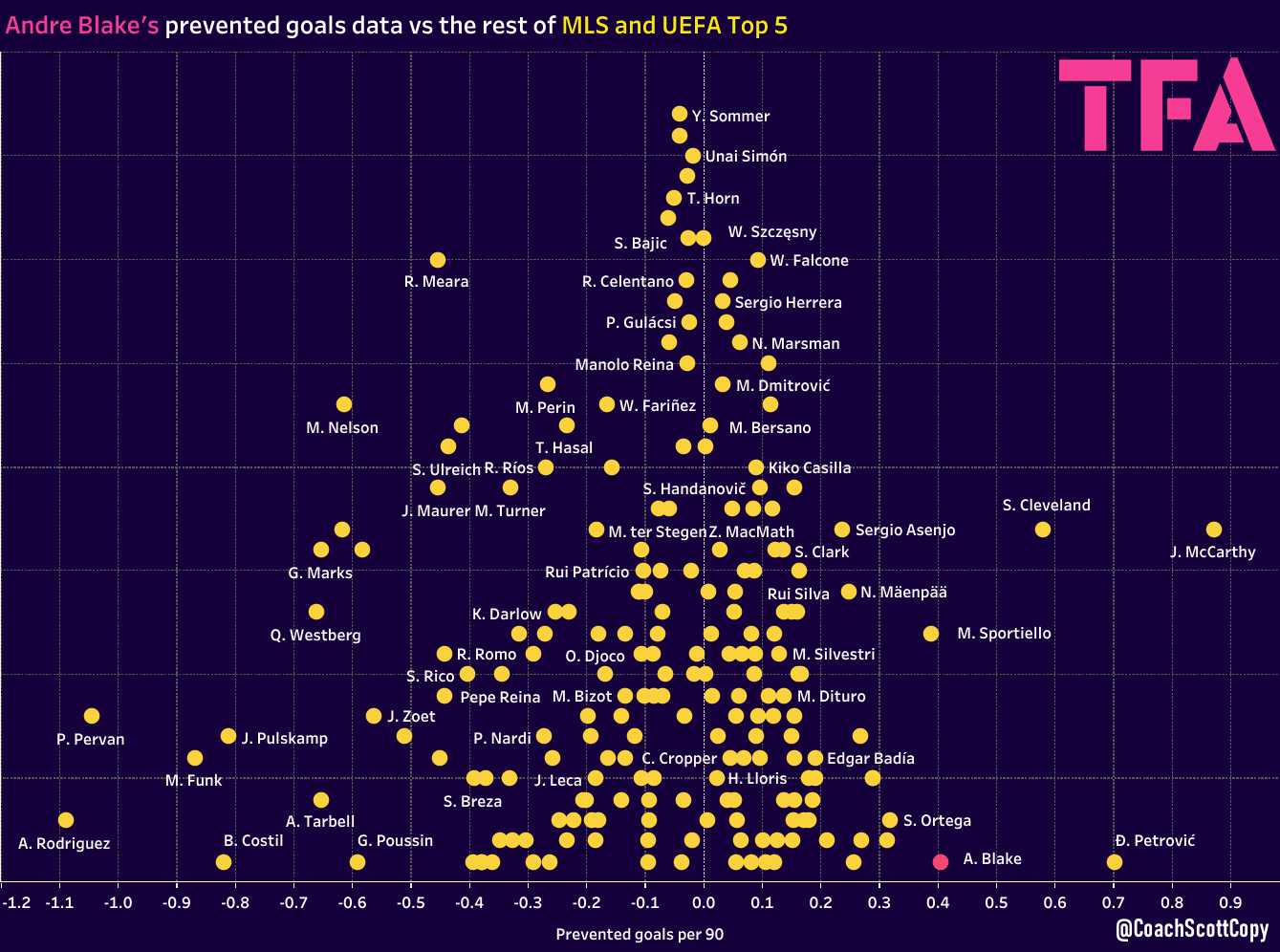
Blake rates higher than any of the European-based goalies in prevent goals P90. Some Serie A, La Liga and EPL goalies come close, but the top four players in the category all represent MLS clubs, albeit James McCarthy and Stefan Cleveland are very much the second-choice keepers for their respective clubs. Realistically, it’s just Đorđe Petrović, the man who made Arsenal’s Matt Turner expendable at New England, who is the clear top performer among full-time players.
Blake is a tremendous shot-stopper, but there’s so much more to his game. Oddly enough, he often doesn’t need to make incredible saves because of the quality of his starting positions, leadership and aggression in covering the space between himself and the backline.
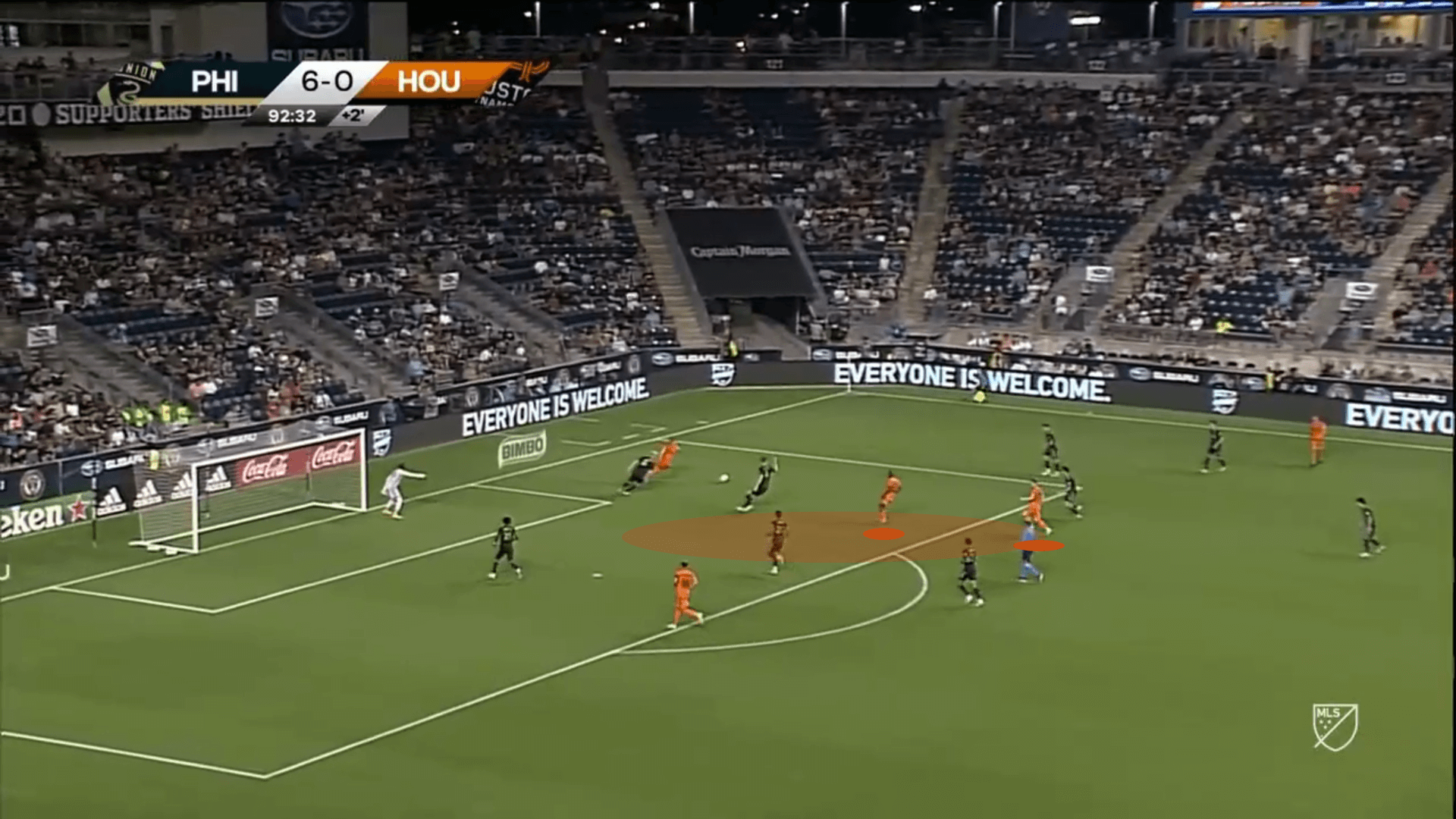
We get a glimpse of that in the images above and below. Even with a 6-0 lead against Houston in the dying seconds of the match, Blake is working hard for his clean sheet. As Houston enters the Philadelphia box, Blake is helping his backtracking defenders identify runners into the box. He has picked out the most threatening opponents and is directing his teammates on who should move where to nullify the threat.
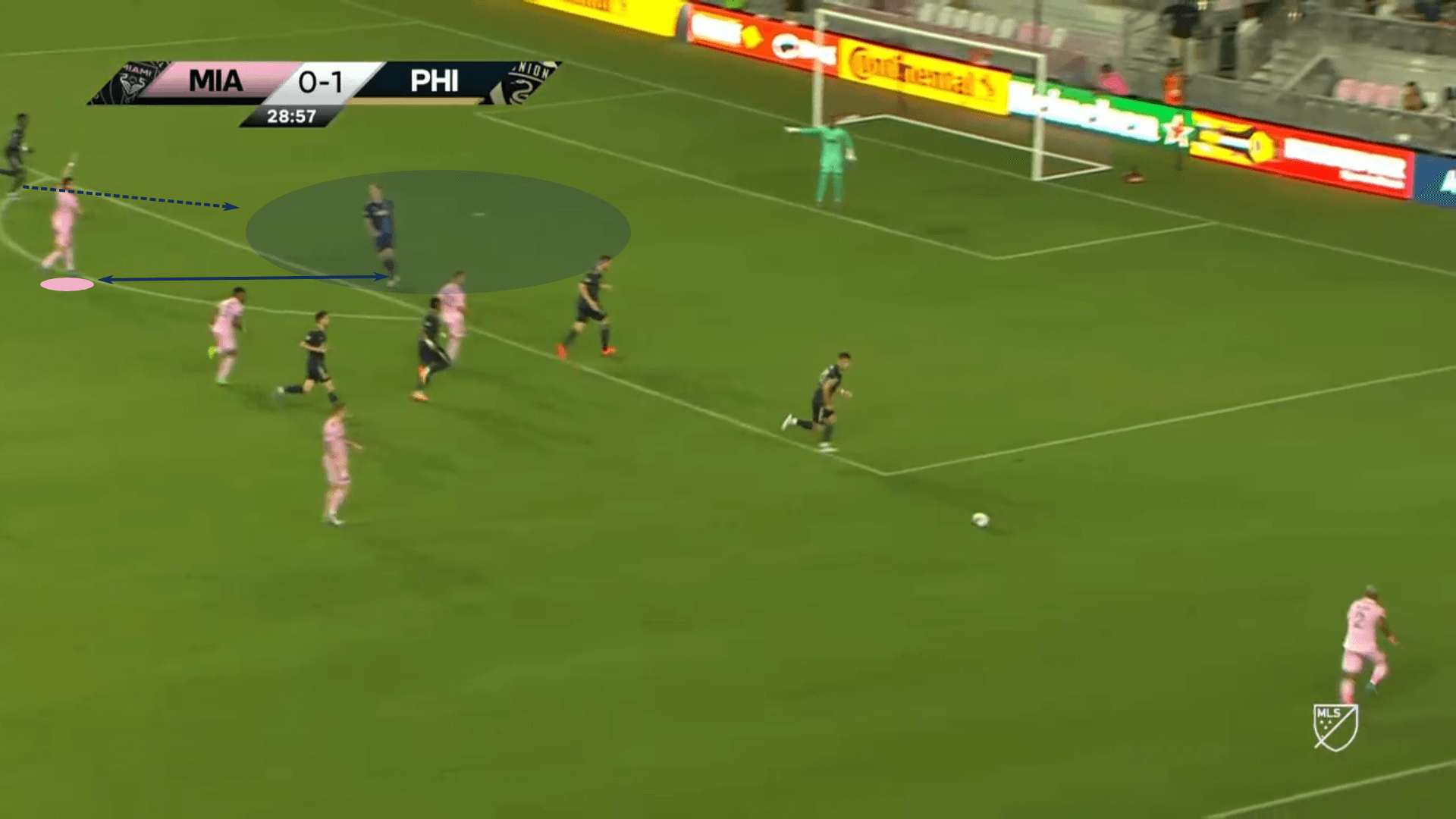
A very similar case happened in Miami. Granted, this is very much part of his style of play, but as the Miami attack moves the ball wide in search of a cross into the box, Blake has taken up an aggressive starting position to deal with the cross and is actively helping his teammates prepare for the delivery. You see him directing his backs to pick up the central runner and add a number centrally to defend against the cross.
Aggressive with his positioning and constantly delivering effective orders to his teammates, Blake consistently positions his Union side for success. There is very little chaos in his box. Philadelphia is well structured which comes down to the impact of their goalkeeper and his leadership at the back.
Sweeper-keeper
Sweeper-keeper is an overused term to describe goalkeepers, but we’re going to use that classification here with Blake. In MLS, you won’t find a better sweeper-keeper.
Tied to his confidence to cover shots from distance, ensuring he won’t get chipped, Blake is extremely aggressive with his positioning. Using the rule of thumb that the goalkeeper should cover two-thirds of the space between the goal line and their backline, Blake shows no fear in protecting his teammates. In fact, he relishes the opportunity to sweep up the opposition’s advances.
Blake will not only cover his backline, but he’s also adept at restarting Philadelphia’s attacks.
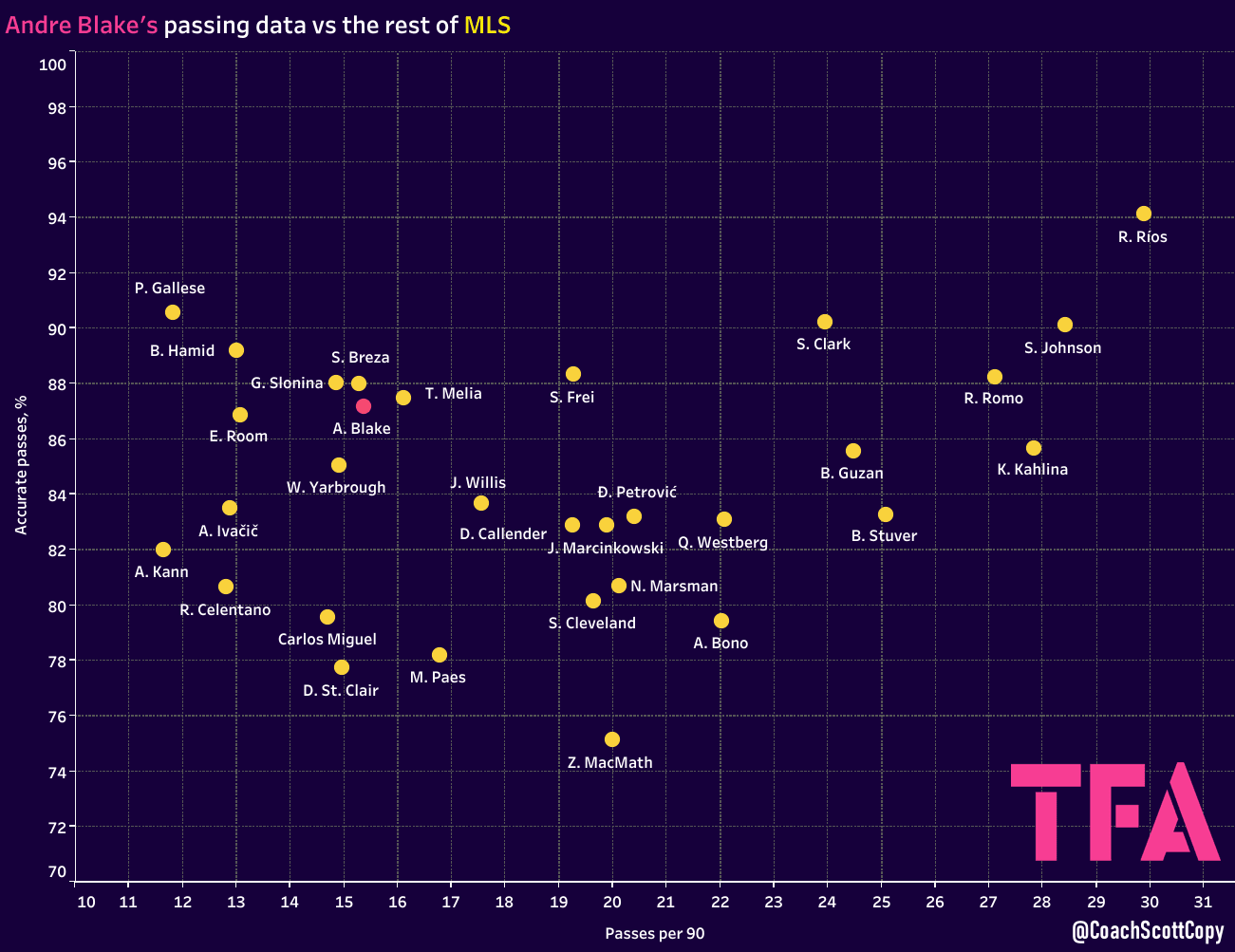
Though he doesn’t average many passes P90, that’s due more to Philadelphia’s direct style of play with limited possession. They rate second from the bottom in possession per match with 42% of the ball, capping Blake’s opportunities to use his feet. Even with their more direct style, he is still one of the more accurate passers in the league.
Simplifying the sweeper-keeper role to two main concepts, the goalkeeper must protect the space behind the backline and help his side restart attacks. That’s exactly what we see in the first tactical example in the section.
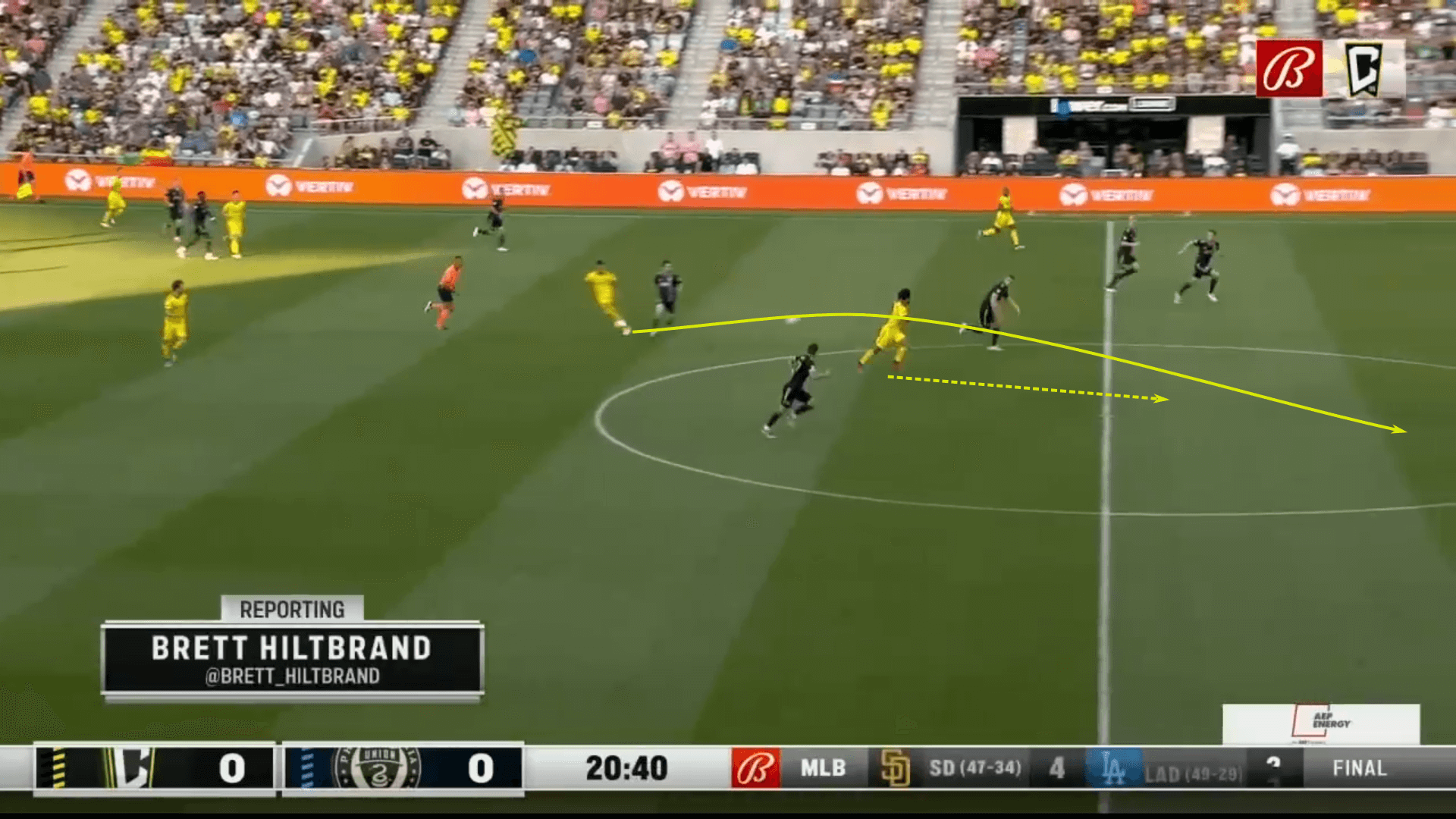
With this first image, the biggest sticking points are the locations of the pass, runner and backline members. In this case, the Columbus Crew found a gap right through the middle of the pitch. It was too good to pass up, so they tried their luck playing the runner through.
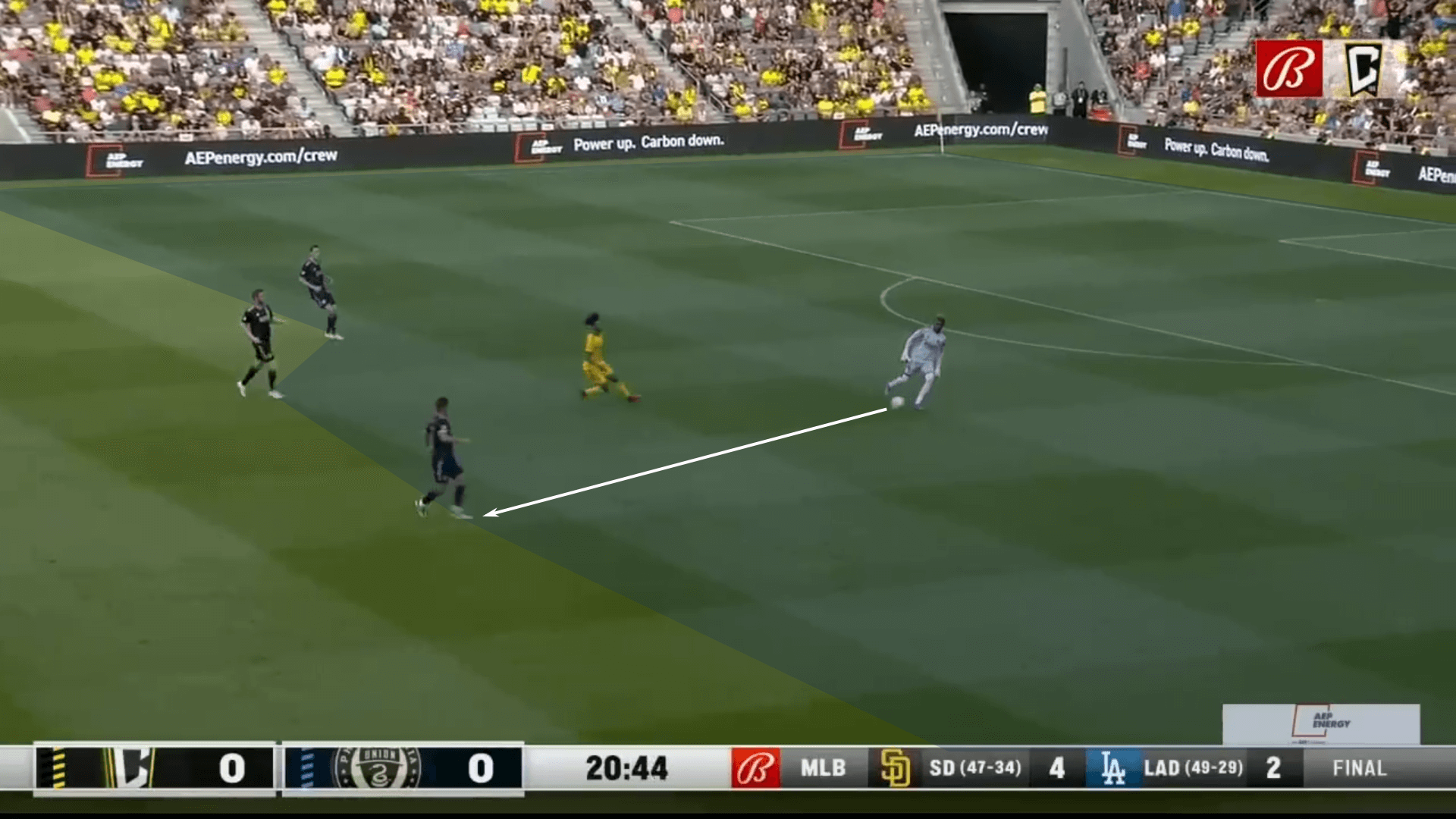
The pass is a bit heavy, but Blake experiences no pressure as it comes out to claim the through ball and restart Philadelphia’s attack. He’s approximately 30 yards off his line and offers even more coverage for his backline, potentially offering up to 40 yards of protection.
When he decides not to risk forward movement, he recovers to his line well while remaining focused on the actions of the first attacker and supporting runners. Orienting his body to maximize his scanning, Blake’s recoveries to goal are typically shuffles back. The opposition’s attacking tempo will play a role in his movement style, but the Jamaican does well to position himself for interventions.
Finally, on the attacking side of the ball, we’ve already seen him restart play after an interception, but Blake also shows a keen awareness of attacking opportunities. The image below shows a simple bowling technique to activate his right-back.
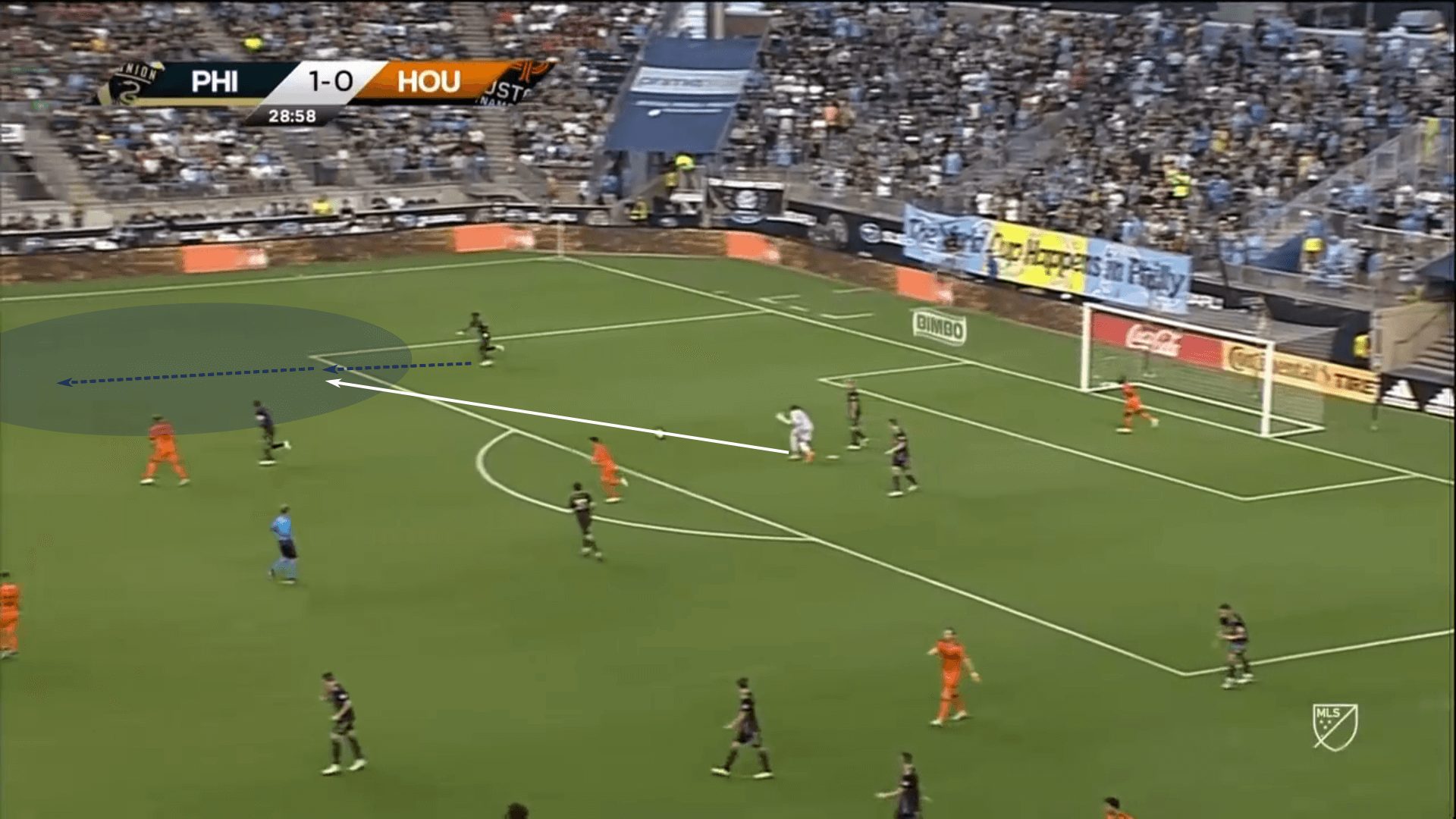
Despite the simplicity of the action, a few things stand out. First, there’s zero laziness in his bowling technique. He gets the ball to his teammate quickly and sends a message with his roll.
Second, look at Houston’s five highest players. They’re slow in transition and simply not ready to defend. Blake’s read catches them in a moment of vulnerability with lots of space to attack.
His read of the game benefits Philadelphia both in and out of possession. He’s the anchor at the back and arguably the most reliable player in the league
Goalkeeper actions
Let’s move to the meat and potatoes of this analysis. Now that we have an idea of Blake’s playing style and role within Jim Curtin’s tactics, let’s analyze his goalkeeping.
As touched upon earlier, Blake is not only one of MLS’s top goalkeepers in terms of preventing goals, but also when held in comparison to UEFA’s top five leagues. Equally impressive is his save percentage. With a rating of 81.63%, the only goalkeeper with a better mark in MLS is the Seattle Sounders back up, Cleveland.
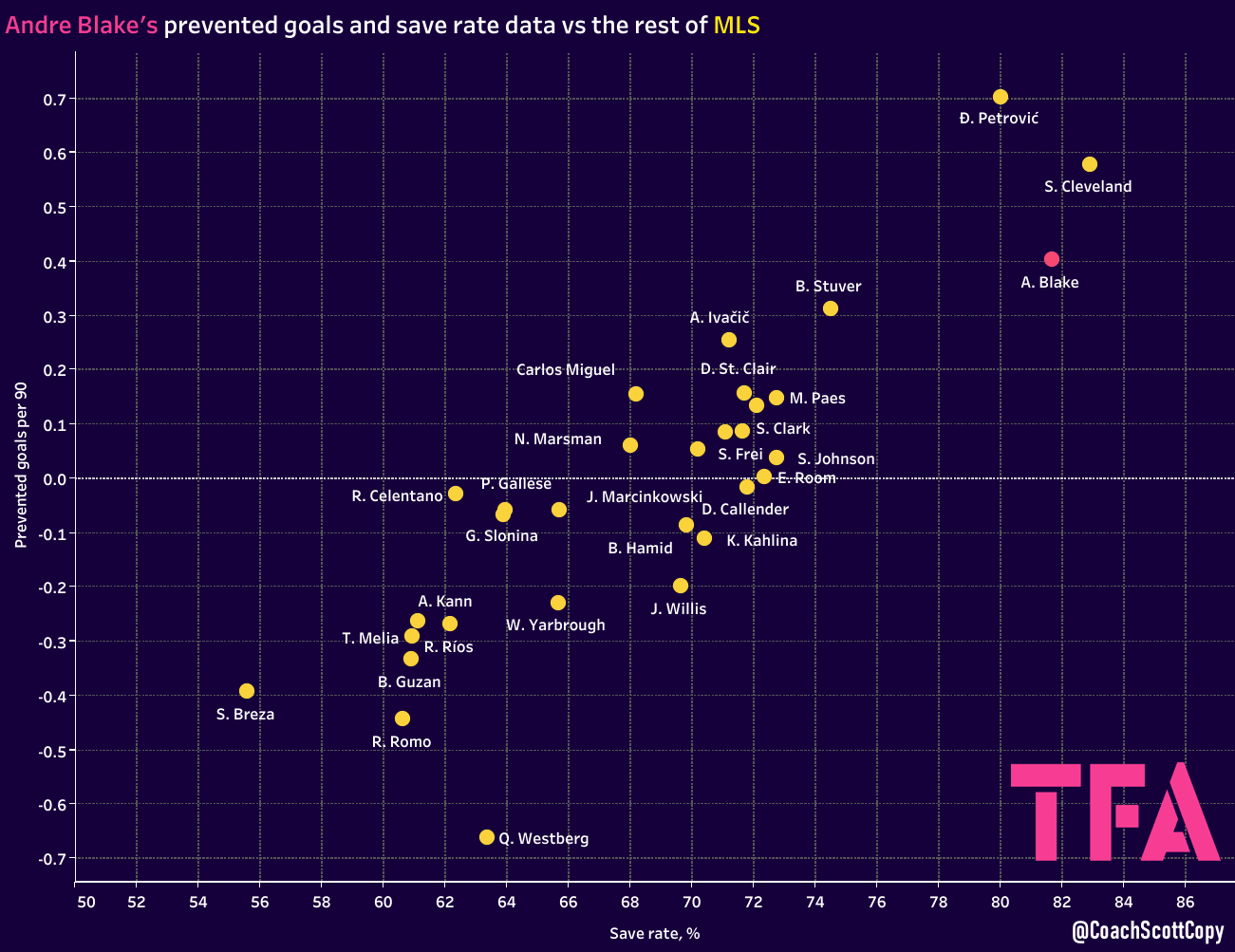
Blake’s performances across the goalkeeping actions statistics is a tour de force. But what underlies the numbers?
When you watch Blake play, it’s incredible how easy he makes difficult saves look. Much of that comes down to his set positioning. You rarely find him shuffling as a shot is taken or late to start his dive. In fact, his footwork is highly impressive. He uses all of his 193 cm length when needed, but he’s also very quick and clean with his footwork.
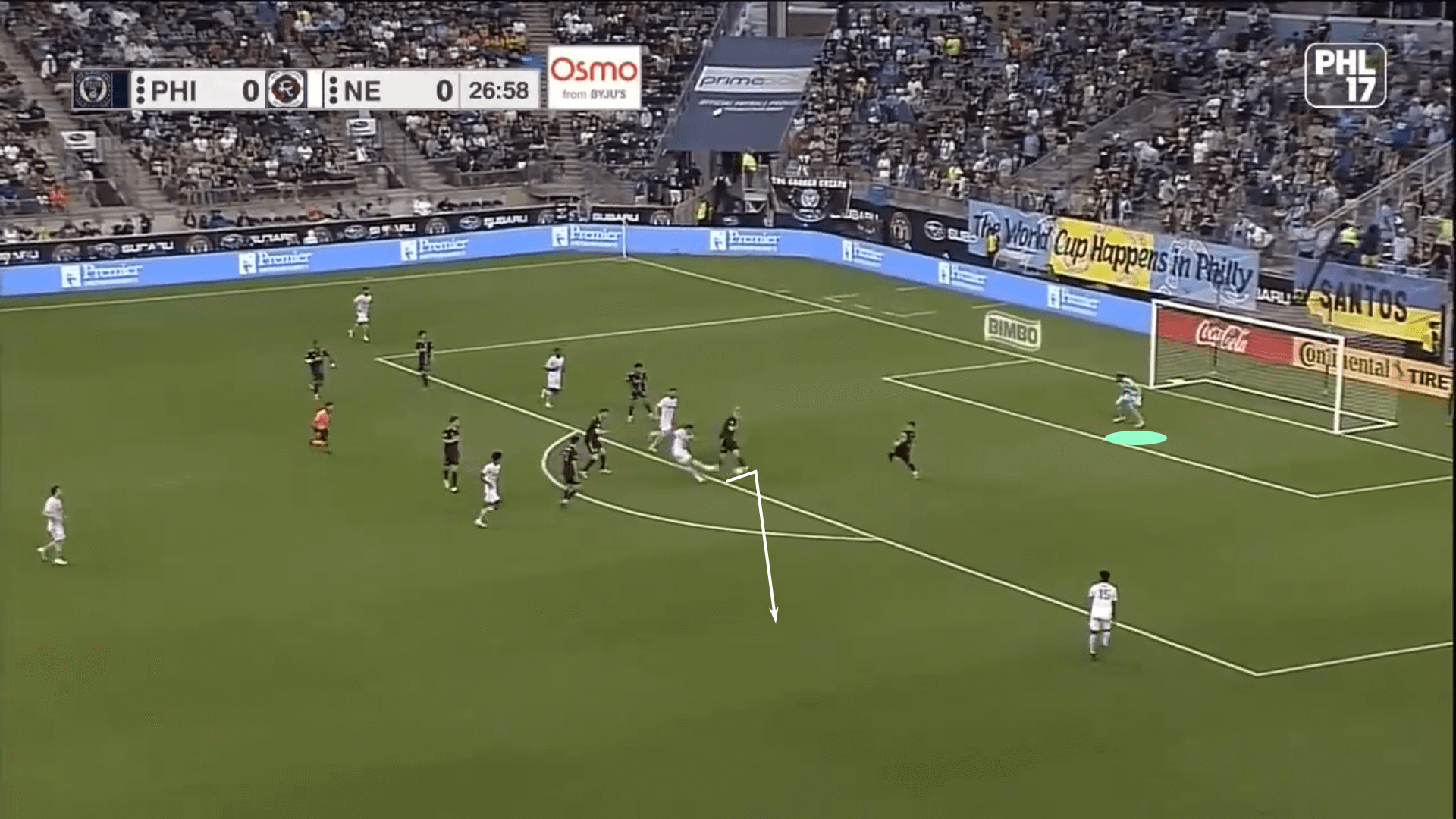
Take this example against the New England Revolution. Though the shot is blocked (this image is captured just before the block), notice that Blake is not only in his set position, but already starting his movement to his right. Had the shot made it past the defender, that’s exactly where it would have gone. Blake’s read and movement are early. If the shot had trickled through, bet on him saving it.
Blake’s preparedness is pivotal to his success. His ability to split his attention between the activity and body mechanics of the first attacker, plus identify threats off the ball and direct teammates are core reasons why he’s not only MLS’s top keeper, but also a realistic MVP option.
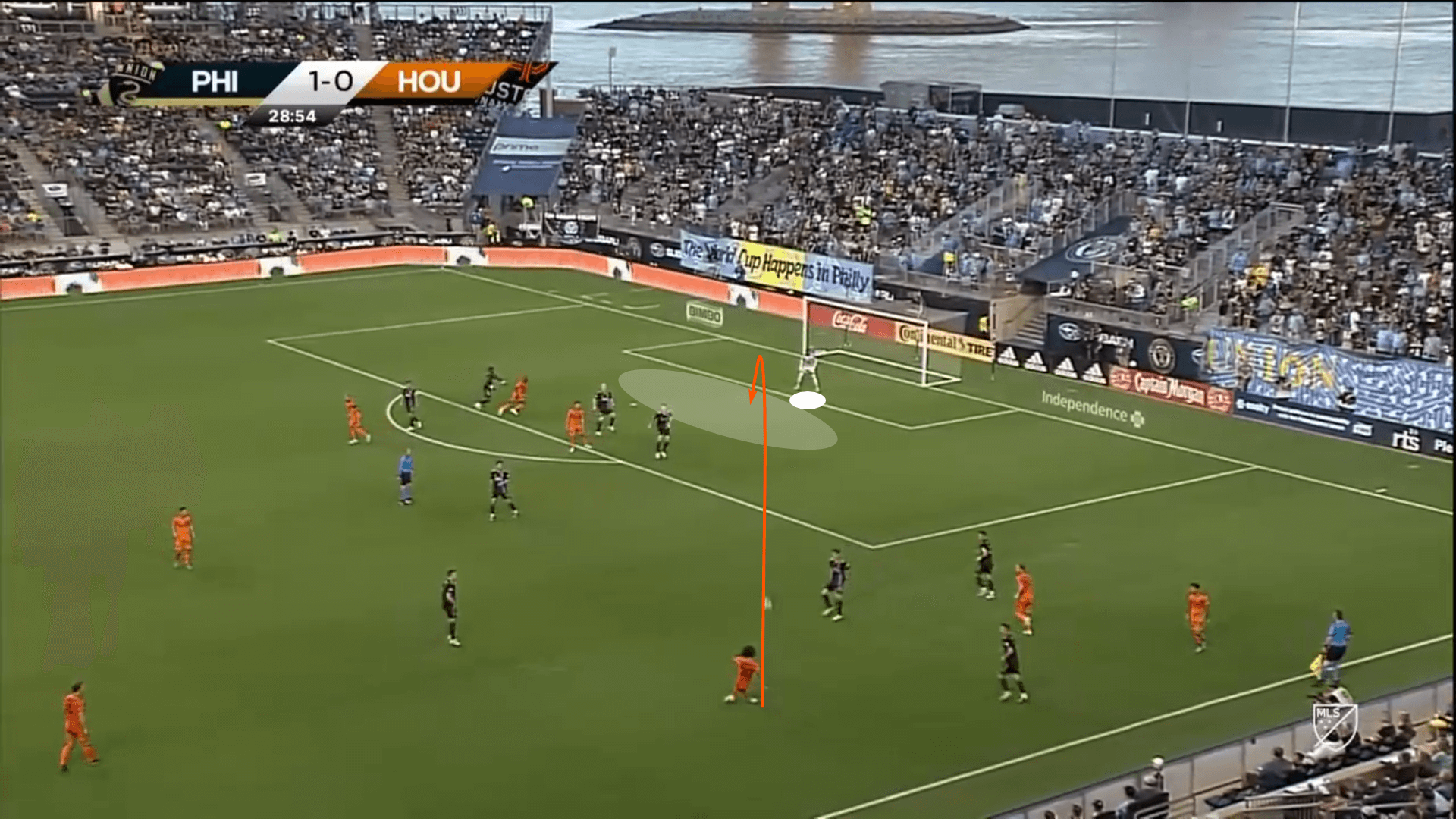
The above example against Houston offers us a glimpse of his football IQ and execution. As Houston crosses the ball into the box, look at Blake’s positioning. He’s 6 yards off his line and his body orientation positions him to move forward. He’s positioned slightly towards his near post, which tells us he’s not anticipating a chip attempt. Instead, he expects the cross to be played into the two high Houston runners. If accurate, the cross will end somewhere in that shaded area.
With his aggressive starting position and awareness of the runner’s positioning, the Jamaican international is prepared to claim the cross. And that’s exactly what he does. As the ball is lifted in, he’s first to it and claims an uncontested catch.
Aggressive starting positions and forward movements are some of his top goalkeeping strengths. Even in the example below, which features a low, bending cross nine yards from the goal line, we can see that Blake is both higher than your average goalie and very quick to start his forward movement. When you watch the film, he anticipates that pass and breaks early to collect it.
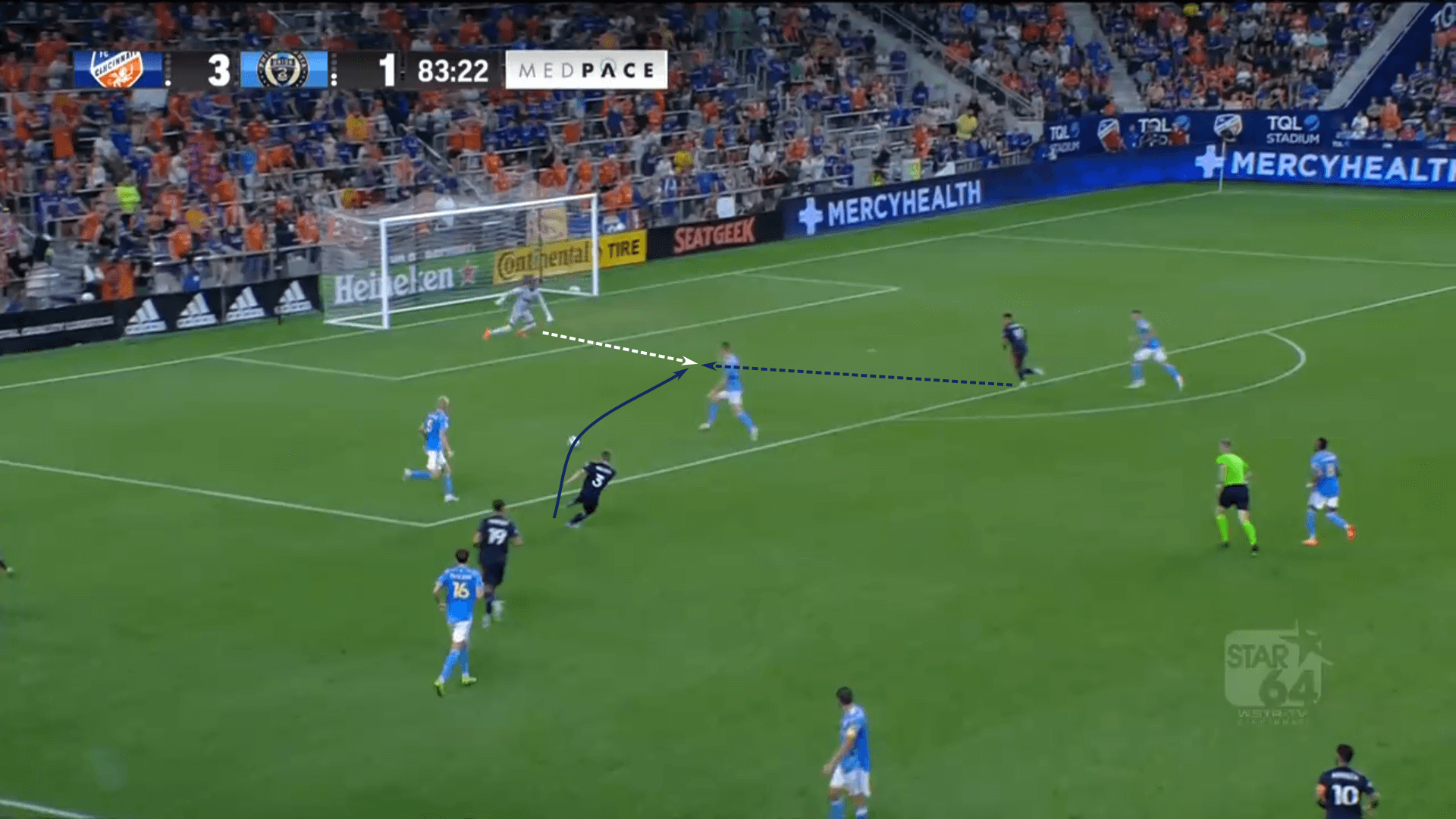
His forward movements help him both to collect passes into the box and to position himself when the opposition can get into scoring positions. His 193 cm frame allows him to block off much of the goal when he can contest the shooter from a more advanced position. With his size, the odds of chipping him from inside the box are slim to none. Knowing that, he has even more freedom to step forward and limit the shooter’s angle to goal.
When he does come off his line to contest shots, he finds that balance between stepping high off his line to narrow shooting angles and ensuring he can get into his set position. The two actions work beautifully together. The first limits the opponent’s angle to goal, requiring pinpoint accuracy to beat Blake. The second ensures that Blake can contest the shot from a balanced stance while also ensuring he’s prepared to move.
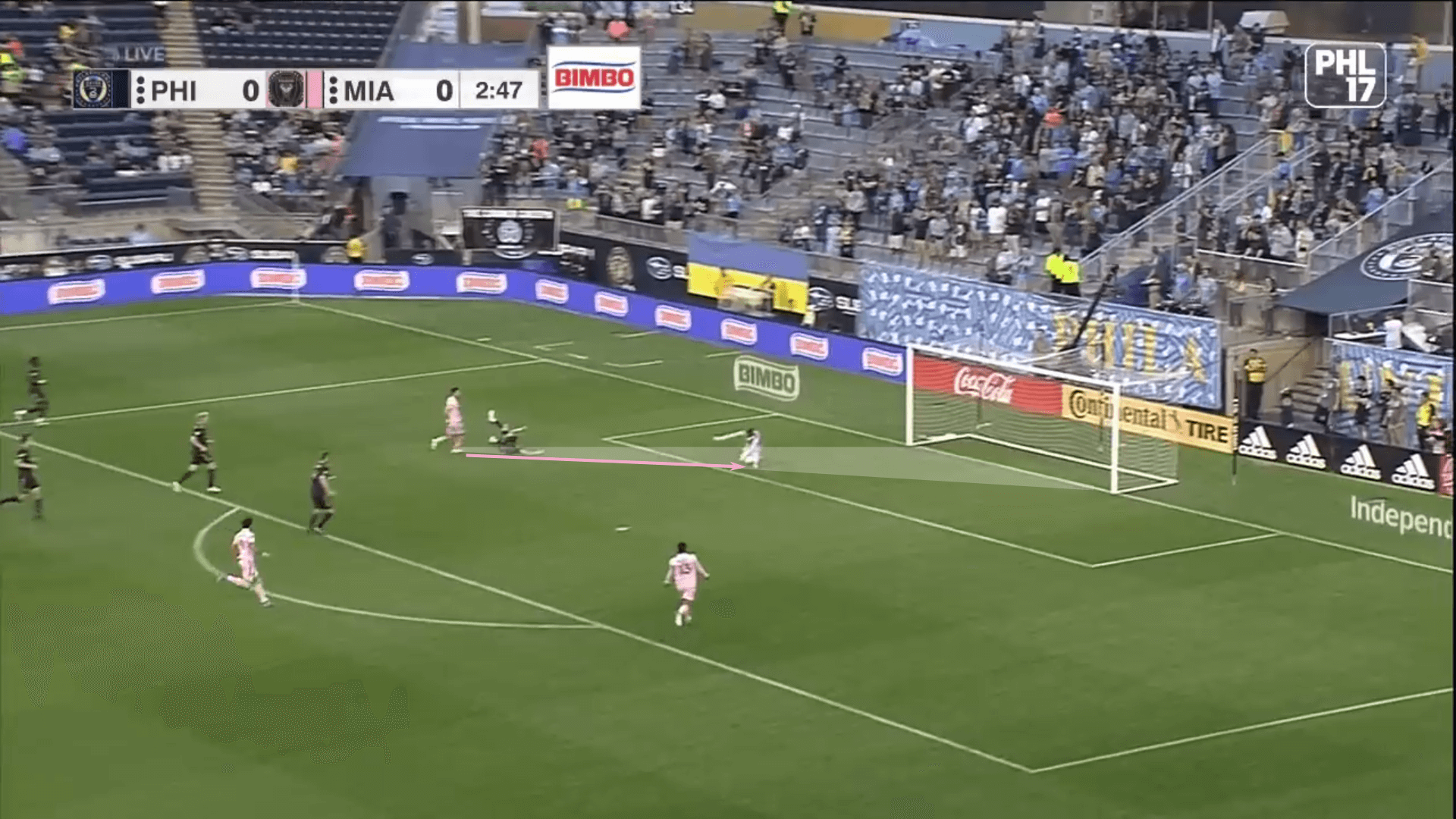
Just look at the angle Blake has covered from this example against Inter Miami. It’s a tough angle, but still one that seems like a good scoring opportunity. However, analysis of Blake’s starting position shows that he has cut off most of the goal. On top of that, he also defended the shot from a set position. In the end, he not only made the save, but he was also able to keep hold of the ball, not allowing a rebound for the far post runner to latch on to.
Finally, Blake’s football IQ is present in his adaptability. He moves very well in the lead-up to a shot. That includes his understanding of angles and possible paths to goal.
Take this example from the match against Chicago Fire. In general, goalkeepers will position themselves on a straight line from the ball to the middle of the goal. That rule of thumb helps them to cover shooting angles in a balanced manner.
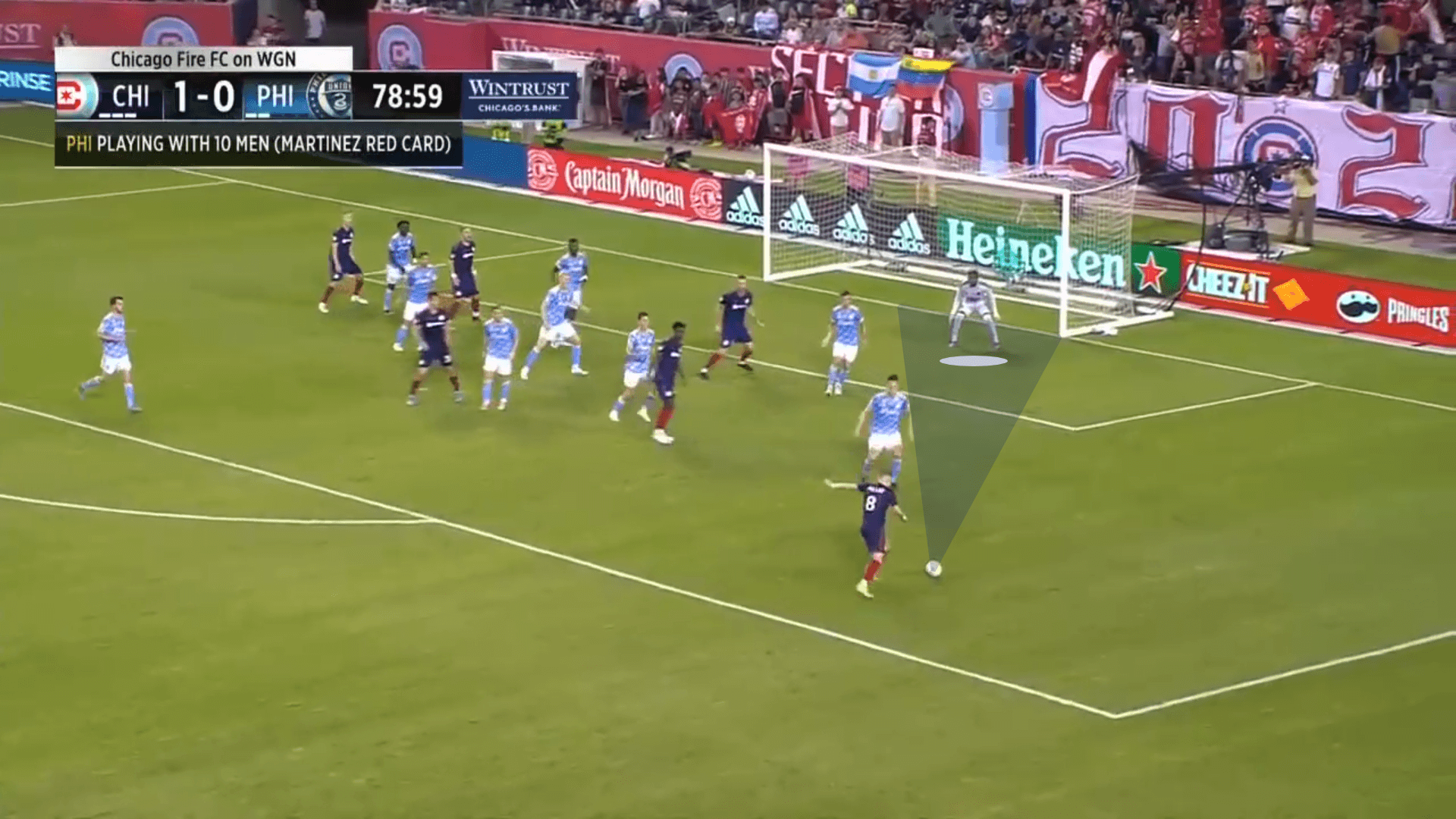
However, look at Blake’s positioning in the final image of the section. He’s a few steps away from that line. Rather than basing his positioning on the line from the ball to the centre of the goal, he does brilliantly to adapt his positioning based on the presence of the defenders in front of him. Granted, a shot can always slip through their legs, but even then, the only possible shot location is the centre of the goal.
Trusting his defenders to protect against a central shot, Blake slides to his left to better defend against a near post shot. That’s the likeliest outcome after all. Taking into consideration the angle blocked off by the first defender, Blake is perfectly positioned within the opponent’s shooting angle.
It’s a brilliant example of adaptability and understanding how his teammates’ positioning impacts shooting locations. It’s also an instance that manifests his high football IQ.
Conclusion
I’ve said it once and I’ll say it again…Andre Blake is my MLS mid-season MVP.
The Philadelphia Union top the Eastern Conference and have the best goals against record in the league, allowing just 18 and 24 matches. LAFC and New York City FC are tied for second with 24 goals conceded. While the manager and players certainly play an important role, Andre Blake’s performances and leadership at the back are clear differentiators.
No goalkeeper has ever won the MLS MVP award. That said, with a congested group of field players competing for top honours, Blake’s influence at Philadelphia, their goals against mark and the Jamaican’s prevented goals and save percentage data may help him break the spell.
MLS 2022 had given us many standout performers, but Andre Blake is in a tier of his own.





Comments